United Technologies Corporation (UTC) was an American multinational conglomerate headquartered in Farmington, Connecticut. It researched, developed, and manufactured products in numerous areas, including aircraft engines, aerospace systems, HVAC, elevators and escalators, fire and security, building automation, and industrial products, among others. UTC was also a large military contractor, getting about 10% of its revenue from the U.S. government. Gregory J. Hayes was the CEO and chairman.
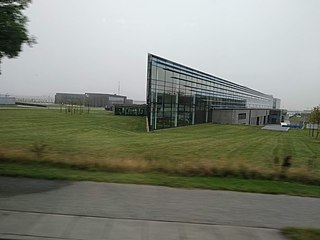
Vestas Wind Systems A/S is a Danish manufacturer, seller, installer, and servicer of wind turbines that was founded in 1945. The company operates manufacturing plants in Denmark, Germany, the Netherlands, Taiwan, India, Italy, Romania, the United Kingdom, Spain, Sweden, Norway, Australia, China, Brazil, Poland and the United States, and employs 29,000 people globally.

Spain is one of the countries with the largest wind power capacity installed, with over 27 GW in 2020.
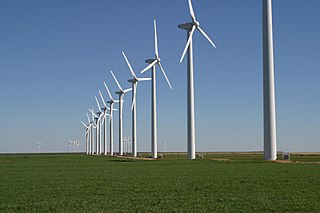
Wind power is a branch of the energy industry that has expanded quickly in the United States over the last several years. From January through December 2022, 434.8 terawatt-hours were generated by wind power, or 10.25% of electricity in the United States. The average wind turbine generates enough electricity in 46 minutes to power the average American home for one month. In 2019, wind power surpassed hydroelectric power as the largest renewable energy source in the U.S.

Siemens Gamesa Renewable Energy S.A., formerly Gamesa Corporación Tecnológica S.A. and Grupo Auxiliar Metalúrgico S.A., is a Spanish-German wind engineering company based in Zamudio, Biscay, Spain. In Spain, the company has two other main sites one in Madrid and the other one in Sarriguren (Navarre). The Services Commercial Office is located in the Parque de la Innovación de Navarra in Sarriguren. It manufactures wind turbines and provides onshore and offshore wind services. It is the world's second largest wind turbine manufacturer.
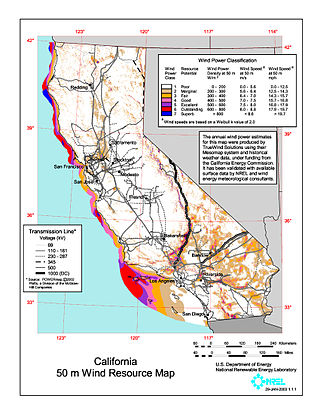
Wind power in California had initiative and early development during Governor Jerry Brown's first two terms in the late 1970s and early 1980s. The state's wind power capacity has grown by nearly 350% since 2001, when it was less than 1,700 MW. In 2016, wind energy supplied about 6.9% of California's total electricity needs, or enough to power more than 1.3 million households. Most of California's wind generation is found in the Tehachapi area of Kern County, California, with some large projects in Solano, Contra Costa and Riverside counties as well. California is among the states with the largest amount of installed wind power capacity. In recent years, California has lagged behind other states when it comes to the installation of wind power. It was ranked 4th overall for wind power electrical generation at the end of 2016 behind Texas, Iowa, and Oklahoma. As of 2019, California had 5,973 megawatts (MW) of wind power generating capacity installed.

The 2.5 MW Liberty Wind Turbine was the largest wind turbine manufactured in the United States when it was first installed in 2007. It was developed through a partnership with U.S. Department of Energy and its National Renewable Energy Laboratory for Clipper Windpower.

China is the world leader in wind power generation, with the largest installed capacity of any nation and continued rapid growth in new wind facilities. With its large land mass and long coastline, China has exceptional wind power resources: Wind power remained China's third-largest source of electricity at the end of 2021, accounting for 7.5% of total power generation.
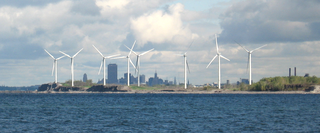
Steel Winds is a wind energy project located on the coast of Lake Erie in Lackawanna, New York, just south of the City of Buffalo in Erie County. Its first phase was operational in 2007 and the second phase came online in 2012, for a combined production capacity of 35 MW. The unique project was built on part of the brownfield of a former Bethlehem Steel plant. By using much of the existing infrastructure of roads and transmission lines, it could reduce project costs. It is one of the largest urban wind farms in the world and uses turbines manufactured in Iowa.

A floating wind turbine is an offshore wind turbine mounted on a floating structure that allows the turbine to generate electricity in water depths where fixed-foundation turbines are not feasible. Floating wind farms have the potential to significantly increase the sea area available for offshore wind farms, especially in countries with limited shallow waters, such as Spain, Portugal, Japan, France and the United States' West Coast. Locating wind farms further offshore can also reduce visual pollution, provide better accommodation for fishing and shipping lanes, and reach stronger and more consistent winds.
The Titan Wind Project is 25MW wind farm which had a proposed expansion to 5,050 MW, formerly known as Rolling Thunder, based in South Dakota. The project developers, Clipper Windpower and BP Alternative Energy, expected to build Titan in several phases and, when completed, it would have been one of the largest wind farms in the world.
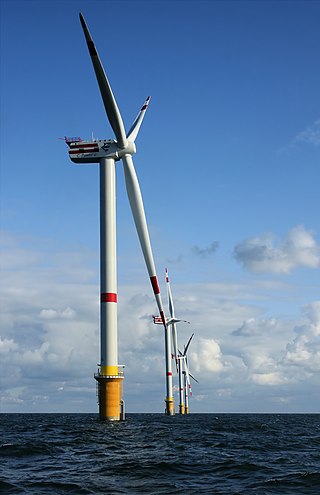
A wind turbine is a device that converts the kinetic energy of wind into electrical energy. As of 2020, hundreds of thousands of large turbines, in installations known as wind farms, were generating over 650 gigawatts of power, with 60 GW added each year. Wind turbines are an increasingly important source of intermittent renewable energy, and are used in many countries to lower energy costs and reduce reliance on fossil fuels. One study claimed that, as of 2009, wind had the "lowest relative greenhouse gas emissions, the least water consumption demands and the most favorable social impacts" compared to photovoltaic, hydro, geothermal, coal and gas energy sources.
Goldwind Science & Technology Co., Ltd., commonly known as Goldwind, is a Chinese multinational wind turbine manufacturer headquartered in Beijing, China. Goldwind was a state-owned enterprise before 2007, with largest shareholders including Hexie Health Insurance, China Three Gorges Renewables Group, and the National Social Security Fund, state-controlled corporations holding almost 40% shares. Its founder, Wu Gang, is a Communist Party member and had a seat in the 12th National People's Congress.
GE Wind Energy is a branch of GE Renewable Energy, a subsidiary of General Electric. The company manufactures and sells wind turbines to the international market. In 2018, GE was the fourth largest wind turbine manufacturer in the world.

James G.P. Dehlsen is an American businessman, inventor, and entrepreneur. He is a pioneering figure in wind power and renewable energy development in the United States and holds 25 patents.

The Criterion Wind Project is a wind farm located on Backbone Mountain east of Oakland, Maryland, United States. The project has a rated capacity of 70 MW and uses 28 Liberty Wind Turbines manufactured by Clipper Windpower. Each of the wind turbines is about 415 feet tall. The Criterion Wind Project is owned by Criterion Power Partners, LLC, which is a subisiary of Exelon, and interconnected with the transmission system of the Potomac Edison Company. Electricity and renewable energy credits from the project are sold to the Old Dominion Electric Cooperative under a 20-year supply contract.

Wind power in Michigan is a developing industry. The industrial base from the automotive industry has led to a number of companies producing wind turbine parts in the state. The development of wind farms in the state, however, has lagged behind. In January 2021, there were a total of 1,481 wind turbines in the state with a nameplate capacity of 2,549 MW. The nameplate total exceeded 2,000 MW when Pine River came online in March 2019. Wind provided 4.2% of the state's electricity in 2016.

Renewable energy sources such as solar, wind, tidal, hydro, biomass, and geothermal have become significant sectors of the energy market. The rapid growth of these sources in the 21st century has been prompted by increasing costs of fossil fuels as well as their environmental impact issues that significantly lowered their use.














